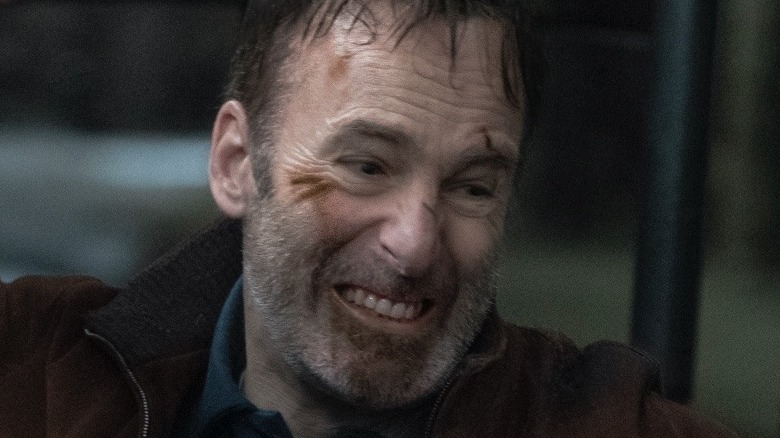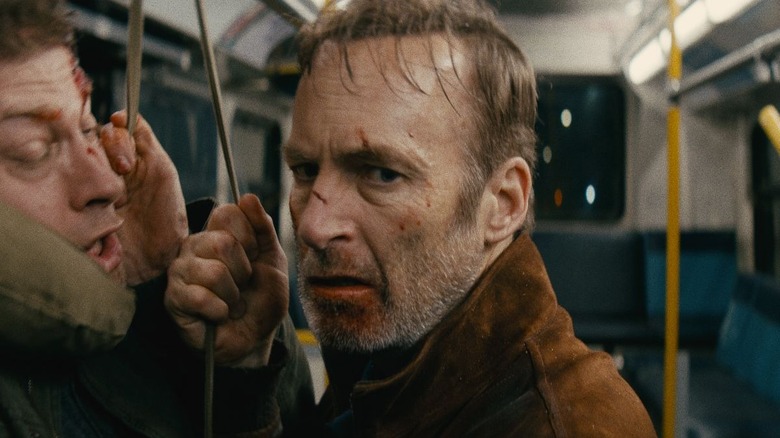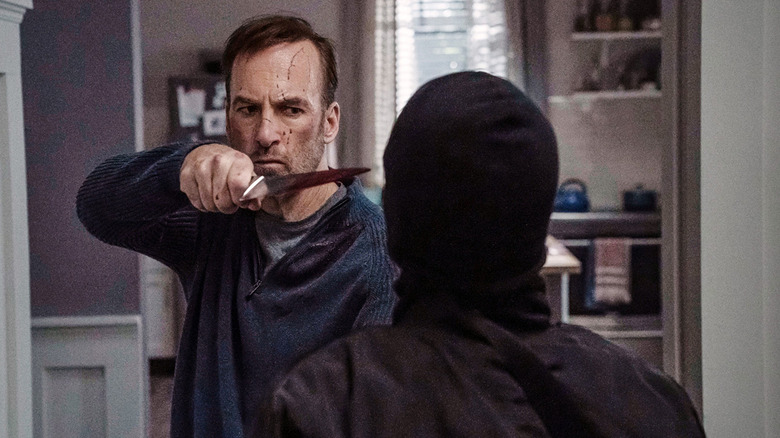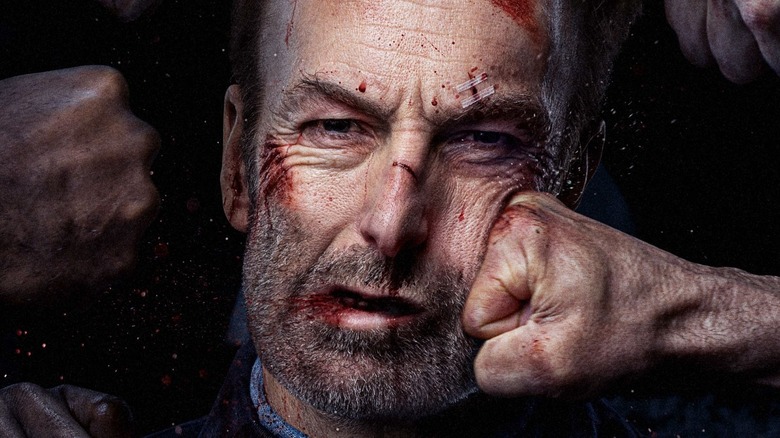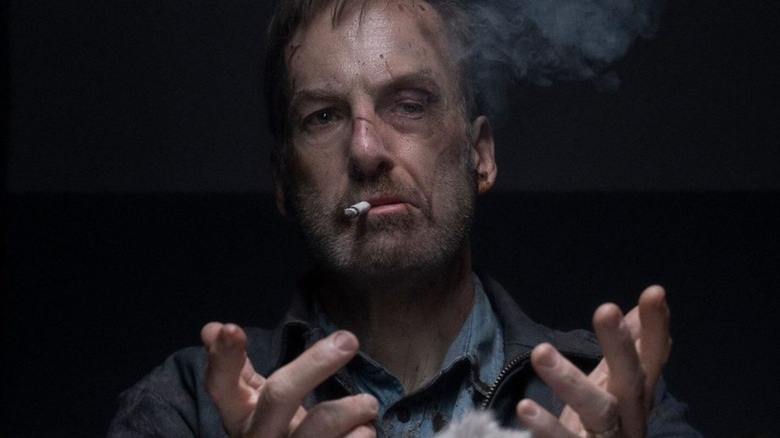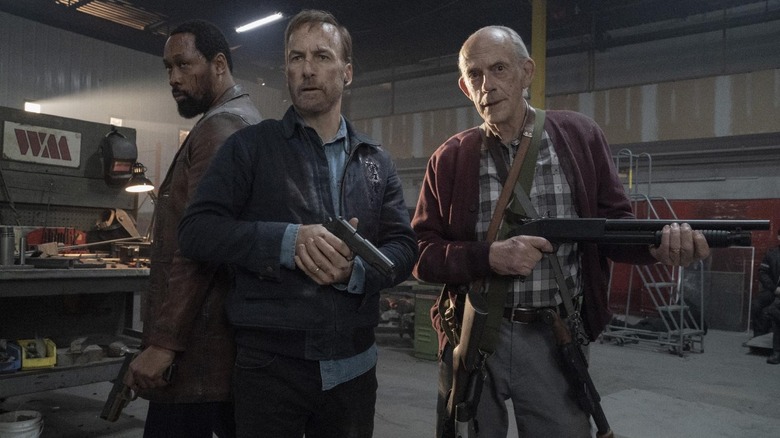Nobody Stunt Coordinator Greg Rementer Reveals The Movie's Most Brutal Moments - Exclusive Interview
Keanu Reeves makes sense as an action hero, even as he gets older. That's a big part of what makes the "John Wick" franchise such an ongoing success — the people behind those films know how to bring out the best action star Reeves can be. An arguably more interesting challenge presented itself to that same "John Wick" team in the form of "Nobody."
In "Nobody," middle-aged Hutch Mansell finds himself pushed to the brink after a pair of criminals try to rob his family's house. Hutch seems to be your average suburban pencil-pusher, but in actuality, he's a former assassin who worked for government agencies in order to make high-profile targets disappear.
What makes Hutch especially interesting as a character is that he's been out of the killing business for a while — and that makes him potentially a little soft. We're certainly supposed to think Hutch might not have the juice anymore because the actor cast to play him isn't an action star — he's Bob Odenkirk, star of "Better Call Saul."
It's an established matter of public record that Bob Odenkirk is a dedicated, talented actor. However, what you may not know is that Odenkirk was so serious about starring in "Nobody" that he spent a year and a half training before pre-production on the film really got underway.
Looper sat down with stunt coordinator Greg Rementer to talk about how Odenkirk prepared to play Hutch, whether he could actually beat stunt actors up in a fight, and which scenes from "Nobody" were the most brutal to create.
Bob Odenkirk's surprise extended fight training
When Looper interviewed RZA, he told us that the thing that really got him into the film, the moment that made him want to dance with it, was the bus sequence. What was it for you about the script that you looked at it and you were like, "Yes, I can mess with this movie"?
I was finishing a movie that David Leitch was directing, and his producing partner and wife, Kelly McCormick, said to me, "What are you doing after this? We've got this great script. Think you'd be amazing. Take a read." And I was super flattered, but also like, "Okay, let's see." Read the script and [my] jaw dropped that I would get a chance to work on this movie. And I thought, "Okay, who are you looking at to lead?" And they said, "Bob Odenkirk." And I immediately went, "Hm, interesting choice. How much time do we have?" And they said, "Well, we have X amount of months," and I thought, "Well, that's troublesome because who knows if Bob can do what we need him to do." And they said, "Don't worry about it. He's already been training for a year." And I thought, "Tell me more about what you mean."
And there's this incredible stunt fight choreographer named Daniel Bernhardt, who if you've seen "Bloodsport II" and "Bloodspot III," he was the lead. And Daniel had offered himself up back when he met Bob, and just became friends with Bob and trained him on his own accord for almost a year to a year and a half. So they said, "Look, just call Daniel and talk to him about it and see what you think. See if that interests you." So I talked to Daniel and I said, "Look, man, can you send me some videos of you training Bob? And that'll tell me right then and there," because the script is incredible. There's no doubt about that.
And Daniel sends me these videos of Bob and him training, and I was blown away. I said, "How old is Bob? And he's doing that already? And we still have four or so months to go before we shoot? I'm in." He was already at a point where he would be what I would consider a seasoned stunt performer, which is a lot to say for a guy of his age, of his caliber, of his wit, of his everything he's done, his resume, but he was already in great shape and was already had the ability to make it look like he knew what he was doing.
And it was a small combination of things that piled up that was the sealed deal that I watched the videos of him. And I said, "All right, let's do this." And then it was just full speed ahead with coming up with ideas about the bus and the house and the finale and what was he going to do and how was he going to do it, and what was his emotion? What was the narrative, the through story, and how can we make this fresh?
And it was already easy, because yes, the team that did this did "John Wick," but Bob Odenkirk is not Keanu Reeves. And that's what makes it so special. He's the guy that we all are. We're the guy that goes to work every day, comes home to his family, his 9:00 to 5:00. Is a little, after 20 years, wishing "Maybe I could try something else." No? And we wonder, we wonder, we wonder, and then we find out, and then he just delivers.
But my favorite story about Bob is, and I don't know if you know of anybody who's ever fought professionally or seen a tiger in a cage that hasn't eaten in a week, but after about two years of fake fighting, you get to this point where you go, "I wonder if I could really fight. I wonder what I could do." And Bob shows up on set for the first night and we're going to go do the fight scene against the four stunt actors, two of which who were the fight coordinators that had been working with Bob. And Bob walks into this bus and he looks like he is a caged tiger who hasn't eaten in weeks. And he starts pacing and he's looking at them with this death stare. And none of the other guys are paying attention to it, because they're making sure that they're prepared and they have all their stuff.
And I went over to Kirk [Jenkins], who was one of the fight coordinators and a stunt actor in the scene, and Daniel, and I said, "God, look at Bob. I think he's sizing you up." And we look over at Bob, and he is. He's pacing back and forth. And I go, "Guys, I think he's going to beat the s*** out of you." All right, here we go. And if you watch the bus fight, when you watch the savagery that Bob brings to the table, that's when we knew it had all paid off and it was worth every minute through and through.
Building Bob Odenkirk's fighting style
What is the relationship between you and Bob once you come on to "Nobody"? What was the work that the two of you did together after he'd already trained for so long?
Basically once I saw those videos and saw him training and I immediately jumped on board, I immediately got on with [director Ilya Naishuller], spoke with him in depth with David and Kelly, and then got on with Bob, talked with him in depth. And the most important thing to Bob, and to me, ironically, that we all had the same sentiment, was that he's not perfect. Hutch is not perfect. He must fail. He must sweat. He must get beaten up. He must bleed. He may not win. And we were all on the same page. And so that was the most important thing to them.
Then I sat with myself. I went and rode some buses. I looked around. I did a lot of research of homemade weapons and compiled a ton of ideas, not just in the way that he would fight, but in the traps that he would create in the finale.
I also have an incredible team. My fight coordinator, Kirk Jenkins, and Daniel also as well, the trainer, helped me in that aspect, too. I rely on our teams to help create these incredible concepts. And then we just, the first thing we did was I got together a bunch of really incredible stunt performers and stunt actors. We created a bus in a stunt gym out of boxes and props. We choreographed it. We shot it like a mini movie. We put it to music, and we presented it sight unseen to any of them, not really telling them about what the choreography was going to be. We had just talked about the narrative, and that was where we stemmed off. And it was the jumping point that really didn't change all that much
But yes, we set it slightly different. We had it to this really somber, classical tone that it was almost like a piece of art that this guy who was off for 20 years came back. So really, then, we took this choreography and we broke it down into sections. And then we enhanced Bob's training for about two months while he was wrapping up "Better Call Saul" in L.A., intensely working out as much as he would on weekends. And two weeks in a row in L.A., almost stepping up to a new level with things that he might not have done before. Some jujitsu, some judo, some knife stabbing, some weapons training at facilities throughout Los Angeles.
And then just when he thought he couldn't get enough, he came to Winnipeg for about a month or two before we started shooting there. We were working in the spaces with the actual performers and just grinding every day. Bob was working out in the morning. Now he's working out cardiovascular with weights two hours in the morning before he would come in. Then he would come to stunt training. He was on a diet, and he was getting absolutely shredded. You can actually see it towards the end of "Better Call Saul." His character starts to look super toned, but to our benefit because he showed up a lean, mean, fighting machine.
And we were just in constant communication about, "Are we taking this character on the right path? And this is why I think it should go this way." And he trusted us wholeheartedly. David and Kelly at 87 North trusted us wholeheartedly. Ilya wholeheartedly had this vision, and we just worked so closely together with all of them to make this savage, seeing that as you watched throughout the other fights, too, again, in constant communication about how he was sloppy. He was messy. He was sweaty. He was aggressive. He was angry. He was brutal.
Beating Bob Odenkirk in a fight
If you got into a fight with Bob Odenkirk at his peak, do you think he would have beat you? Was he that tough?
There's a number of skillsets that Bob may not have had that I had or anybody might've had, but what Bob had that people at their peak of their career have is the mindset. So I'll tell you right now, the thing, like Captain America, he would stand up and say, "I can do this all day." That's what Bob had. He was in peak physical condition and a mental mindset that, yeah, sure, maybe I could have used techniques Bob doesn't have, but he would've fought. He would've kept going. And that to me is what you see on the screen.
That was more important than how many skills or how many black belts anybody has. Bob had the fighter's mentality and the physical shape. Now, granted, we didn't want everybody to know he had that physical shape, especially in the bus fight, but he had it. I mean, you watch a two-minute fight that we did over the course of two days that Bob did take after take after take after take. Some of the stunt guys were exhausted, and Bob's like, "Give me a minute. All right, I'm good. Let's go."
I can't say he's going to beat me, but it would have been fun. It would have been fun. And I think he would have been game, and that's what I love about him.
The visual language of Nobody
How do you figure out the visual language for this specific movie?
It's a multi-layer sandwich. It starts from the rawest form of we have a library of how to physically move and we teach [Bob] that. And we go, "Okay, he's really good at turning his hips. He's really great at this move, striking. He's really great at this move. Okay. I really truly believe that Hutch would hammer fist guys' faces in. Check. Let's get him hammer fisting guys. He's really good at elbows. I feel like he would use those, because he would slice people's faces open with his sharp elbow. His kicks aren't his strong suit. We don't need to kick. He's really great at knees. I would use my knees and my elbows before I would kick, anyway." So we just find those languages, and that's how we start.
Then we trained Bob, and then we build upon that. For example, hammer fisting, right? There's a huge story point in the movie that this watch was his father's watch. And maybe it was a small point, but to us it was a big point that he just decided that after he gets stabbed in the bus, he was just going to put a watch over his fist, and as he hammers the guy's face, now he's hammering them with his watch that was stolen. Stuff like that, just building in constant layers of what he's going to do and what he's going to utilize around himself. For example, he finds a bag, and without even thinking, he puts it around the guy's head and chokes him and hangs him.
Severely underplayed, but also extremely interesting that we had to have this props department build us a special bag that it was just your ordinary bag so that we can just layer, layer, layer.
And then on top of that, as the second unit director, it was important that the visual language was shown in specific angles, whether it was handheld or studio mode. So we wanted the handheld nature to come across in the bus, because it was meant to feel aggressive. And there was movement and pushes and pulls and shake and Dutch until all the way through to the finale where it was meant to feel calm, cool, and collected. He had gotten his groove back, so now we were on dollies. We were on sliders. We were on cranes. So every step of the way, the visual language and the physical language have to intertwine. And when to find times to just stop and breathe. And the choreography isn't as important, that the moment where Bob has really just gone for it for a bit, and then all of a sudden they sit down and the seat breaks and there's a moment to breathe, and we realize there's a knife inside of him, but he redeemed himself.
He gets smashed out of a window, and everybody pauses. The moments. So once we build the choreography and the language, then find the moments, find the narrative, find the story, put the camera with it, sync them together, find your actor strengths, and just toss the salad and create something fun. Even if it's not the most original, most inventive camera move that was with a car through a wall, it was there with Bob watching this guy do it. That's it. And that was where it all comes down to in the end. Because if Bob could do it, I wanted Bob to do 100% of it until he couldn't.
The most brutally violent moments in Nobody
When you go back and look at the final cut of "Nobody," is there a stunt that just hits exactly right?
There's a couple that I really, really was proud of on "Nobody." When Bob kicks the guy's knife into the guy's leg, it just makes me want to throw up a little bit. When Bob goes out the window, his double's leg gets caught up on the window and it just looks like it pulls his leg out of the socket. It's just violent. It's really dirty. It's real glass. There's no way around it. It's just painful. In the house when he's beating the guys with the baseball bat, just the sound of a baseball bat hitting a person's skull is awful. It's terrible.
We also smashed a man's skull with a teapot. That was pretty awful. There was actually a piece in there that didn't make the movie. We created this piano gag where we were going to smash a guy's face into a piano and I was sad it didn't make it. We're going to save that for another movie.
One of my favorite gags doing the movie, just because I love how it connected the two, was when RZA wrapped the guy up in the barbed wire and sent him out the window, and that guy lands on the ground next to Christopher Lloyd. That was especially a really fun moment, I think, because I always love trying to find a challenge of taking some stunt and tying it with two storylines, and that takes good planning and again, a great team to achieve that.
And then I think we had a couple good car gags that were quite painful as well. But one I'm really proud of is we crashed a car into a telephone pole. And then I think most people overlook the moment, but you'll notice the car flips, lands, and all in one shot without cutting, Bob comes out of the trunk and then continues around. I won't tell you how we did it, but I was really proud of it, because it's really exciting to flip a car and have Bob Odenkirk pop out of the trunk all in the same shot.
"Nobody" is now available through Video on Demand and on Blu-ray and 4K Ultra HD.
